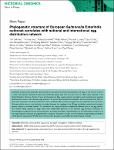Phylogenetic structure of European Salmonella Enteritidis outbreak correlates with national and international egg distribution network
Dallman, Tim
Inns, Thomas
Jombart, Thibaut
Ashton, Philip
Loman, Nicolas
Chatt, Carol
Messelhaeusser, Ute
Rabsch, Wolfgang
Simon, Sandra
Nikisins, Sergejs
Bernard, Helen
Hello, Simon le
da-Silva, Nathalie Jourdan
Kornschober, Christian
Mossong, Joel
Hawkey, Peter
Pinna, Elizabeth de
Grant, Kathie
Cleary, Paul
Outbreaks of Salmonella Enteritidis have long been associated with contaminated poultry and eggs. In the summer of 2014 a large multi-national outbreak of Salmonella Enteritidis phage type 14b occurred with over 350 cases reported in the United Kingdom, Germany, Austria, France and Luxembourg. Egg supply network investigation and microbiological sampling identified the source to be a Bavarian egg producer. As part of the international investigation into the outbreak, over 400 isolates were sequenced including isolates from cases, implicated UK premises and eggs from the suspected source producer. We were able to show a clear statistical correlation between the topology of the UK egg distribution network and the phylogenetic network of outbreak isolates. This correlation can most plausibly be explained by different parts of the egg distribution network being supplied by eggs solely from independent premises of the Bavarian egg producer (Company X). Microbiological sampling from the source premises, traceback information and information on the interventions carried out at the egg production premises all supported this conclusion. The level of insight into the outbreak epidemiology provided by whole-genome sequencing (WGS) would not have been possible using traditional microbial typing methods.
Dateien zu dieser Publikation
Keine Lizenzangabe

